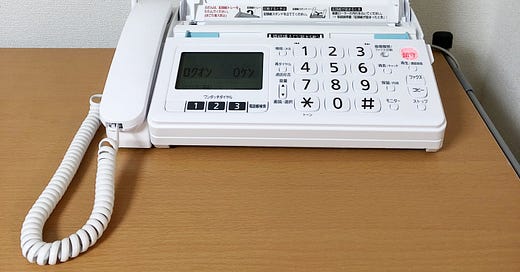A love letter to fax machines
Reminiscing its life from heyday to ejection from Japanese offices
I remember as a child living in Canada in the 1980s, writing letters to my Japanese grandparents on a blank piece of paper and feeding it through a fax machine. A day or two later, the machine would slowly roll out some thermal paper with Japanese writing on it - a response from my grandparents. Hearing the mechanical sounds of the fax machine, we would all rush to tear the paper out and read what news our Japanese relatives had to say. Back then, it was magical to receive instantaneous literature from such a far distance. Our entire family, and many immigrant families around the world during that time, used fax machines with much joy and gratification.
Fast forward to the early 2000s and I clearly remember my love for fax machines quickly dissipating at my first office job. Almost all faxes were spam and we had to recycle most of the print outs, but we couldn’t eliminate the fax entirely because the company was still receiving daily faxes for sales reporting. Perhaps this is how young Japanese office workers feel today, except it’s 2021.
When it comes to the history of fax machine use, Japan was an early adopter, being one of the first countries to allow fax transmissions over phone lines in the early 1970s. Today it is still a crucial part of Japanese business. But why? This could be attributed to the fact that Japan has one of the oldest populations in the world with most management positions filled by older generations. Perhaps these showa era (1926-1989) workers are not comfortable using new technology as they tend to stick to tried and tested methods. If only they were as open to using digital signatures and management software as they were quick to adopt fax machines...
Japan is keen on sticking to legacy formats. The use of hanko stamps is a good example. Name stamps have been around for millenia, however, it was only in the meiji period (1868-1912) that it was used by the general population. Since then, it has become an essential part of Japanese life, necessary for signing contracts, opening bank accounts, and even receiving mail parcels. Although many organisations are becoming more flexible and allowing the use of signatures, hankos are still widely used today, which is the likely reason why fax machines are still around. Printed documents allow the imprint of hankos.
During COVID-19 there have been many news reports on the fact that Japanese organisations are still using the hanko alongside fax machines. For the first half of 2020, hospitals were reporting new coronavirus cases via handwritten faxes before switching to an online reporting system. This, as you can imagine, caused delays and errors during a time when no one could afford the time or misinformation. As a result, the Ministry of Health had no choice but to adopt some changes due to the pandemic.
Although effort has been made to try and abolish the out-dated machines, not all government departments have welcomed digital transformation. Most recently, hundreds of Japanese government workers fought against the government’s decision to end the use of faxes, some going as far as saying that it would be “impossible”. As a result, the fax machines are staying for the time being, meaning government ministries and agencies face the ongoing issue of having to commute to the office.
So why do the Japanese adamantly stand by fax machines over other more modern business tools? Ask an office worker and they’ll tell you they prefer the old facsimile because they need to produce hanko stamps on printed documents for approval and papertrail. Ask a bank teller and they’ll say faxes are safer for handling personal information, with emails posing a security risk. One theory I’ve heard is that the Japanese government cannot afford to lay off all the fax machine attendants and put them on welfare. My view is that in Japan there is a supreme love for bureaucracy and the fax machine is the perfect tool of the modern bureaucrat.
Yet sometimes this bureaucratic inefficiency can be translated as thoughtfulness or meticulous customer service. The Japanese prefer to quadruple check paperwork to ensure no mistakes are made that would cause inconveniences. They also appreciate the art of handwritten notes and letters, which could be one of the reasons why they prefer fax over emails. I have to admit, I personally miss handwritten letters the way I miss meeting people in person. I hope we don’t end up in a world of digital greeting cards and video calls, with no in-person interaction with people in real life. Yes, the fastest route to ridding Japan of fax machines is by abolishing the use of hanko stamps for official documents. But the 2000-year-old hankos are part of Japanese history, ingrained into its customs and culture... and so are fax machines to a certain extent. Dare I say it, if they remove fax machines, some of Japanese culture may go along with it.






